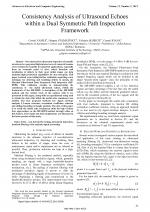| 2/2015 - 6 |
Consistency Analysis of Ultrasound Echoes within a Dual Symmetric Path Inspection FrameworkVASILE, C. |
| Extra paper information in |
| Click to see author's profile in |
| Download PDF |
Author keywords
non-destructive testing, automated inspection, matched filtering, echo analysis, signal processing
References keywords
ultrasound(8), ultrasonics(6), tuffc(6), frequency(6), ferroelectrics(6), control(6)
Blue keywords are present in both the references section and the paper title.
About this article
Date of Publication: 2015-05-31
Volume 15, Issue 2, Year 2015, On page(s): 45 - 50
ISSN: 1582-7445, e-ISSN: 1844-7600
Digital Object Identifier: 10.4316/AECE.2015.02006
Web of Science Accession Number: 000356808900006
SCOPUS ID: 84979796984
Abstract
Non-destructive ultrasound inspection of metallic structures is a perpetual high-interest area of research because of its well-known benefits in industrial applications, especially from an economic point of view, where detection and localisation of defects in their most initial stages can help maintain high production capabilities for any enterprise. This paper is aimed at providing further validation regarding a new technique for detecting and localising defects in metals, the Matched Filter-based Dual Symmetric Path Inspection (MF-DSPI). This validation consists in demonstrating the consistency of the useful ultrasound echoes, within the framework of the MF-DSPI. A description of the MF-DSPI method and the related work of the authors with it are presented in this paper, along with an experimental setup used to obtain the data with which the useful echo consistency was studied. The four proposed methods are: signal envelope analysis, L2-norm criterion, correlation coefficient criterion and sliding bounding rectangle analysis. The aim of this paper is to verify the useful echo consistency (with the help of these four approaches), as the MF-DSPI method strongly relies on this feature. The results and their implications are discussed in the latter portion of this study. |
| References | | | Cited By |
Web of Science® Times Cited: 0
View record in Web of Science® [View]
View Related Records® [View]
Updated 2 weeks, 5 days ago
SCOPUS® Times Cited: 0
View record in SCOPUS® [Free preview]
There are no citing papers in the CrossRef Cited-by Linking system.
Disclaimer: All information displayed above was retrieved by using remote connections to respective databases. For the best user experience, we update all data by using background processes, and use caches in order to reduce the load on the servers we retrieve the information from. As we have no control on the availability of the database servers and sometimes the Internet connectivity may be affected, we do not guarantee the information is correct or complete. For the most accurate data, please always consult the database sites directly. Some external links require authentication or an institutional subscription.
Web of Science® is a registered trademark of Clarivate Analytics, Scopus® is a registered trademark of Elsevier B.V., other product names, company names, brand names, trademarks and logos are the property of their respective owners.
Faculty of Electrical Engineering and Computer Science
Stefan cel Mare University of Suceava, Romania
All rights reserved: Advances in Electrical and Computer Engineering is a registered trademark of the Stefan cel Mare University of Suceava. No part of this publication may be reproduced, stored in a retrieval system, photocopied, recorded or archived, without the written permission from the Editor. When authors submit their papers for publication, they agree that the copyright for their article be transferred to the Faculty of Electrical Engineering and Computer Science, Stefan cel Mare University of Suceava, Romania, if and only if the articles are accepted for publication. The copyright covers the exclusive rights to reproduce and distribute the article, including reprints and translations.
Permission for other use: The copyright owner's consent does not extend to copying for general distribution, for promotion, for creating new works, or for resale. Specific written permission must be obtained from the Editor for such copying. Direct linking to files hosted on this website is strictly prohibited.
Disclaimer: Whilst every effort is made by the publishers and editorial board to see that no inaccurate or misleading data, opinions or statements appear in this journal, they wish to make it clear that all information and opinions formulated in the articles, as well as linguistic accuracy, are the sole responsibility of the author.



